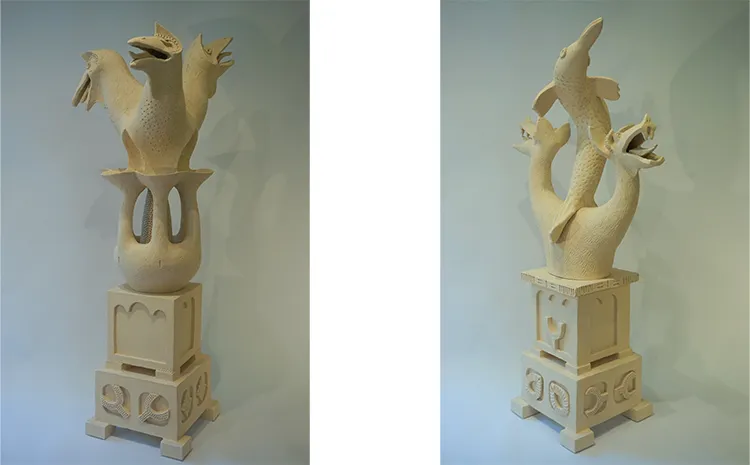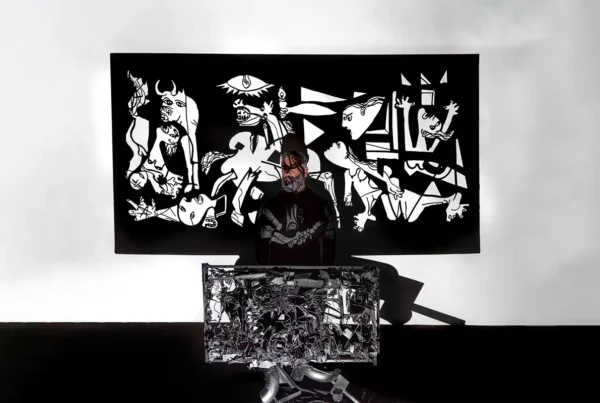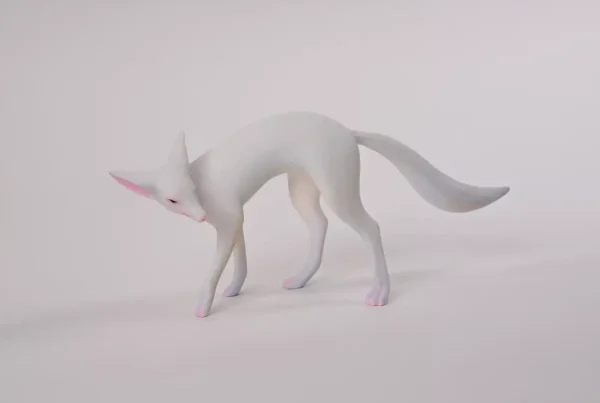“Engaging in the process of creating art encourages me to slow down, reflect, and ignite my imagination. By connecting openly and curiously with the world beyond our personal limits, we cultivate a sense of wholeness that is essential for both humanity and the world at large.”
A Life Shaped by Borders and History
Hedy Abeling‘s journey as an artist is deeply rooted in her upbringing in the small, nature-surrounded community on the outskirts of Ter Apel, near the German border. Growing up in a place where the boundary between countries was both a literal and figurative presence, she developed a unique perspective on the world. This duality of borders—both geographical and metaphorical—instilled in her a constant quest for the “other,” leading her to explore different viewpoints and the delicate balance between separation and connection. The presence of a centuries-old monastery near her home further enriched her imagination, imbuing her with a sense of history and timelessness. The ancient walls and windows of this monastery bore silent witness to a bygone era, fueling her fascination with the interplay between past and present, and the lingering influence of history on contemporary life.
From an early age, Abeling sought various outlets to express her creative energy, experimenting with poetry, drawing, and fashion design. However, the world of art seemed distant and inaccessible in her youth. This sense of distance only deepened her resolve. At 18, she took a decisive step towards her passion, boarding a bus alone to visit the art route in Groningen. This experience ignited a spark within her, a burning desire to pursue art as a career. However, family circumstances steered her towards teacher training rather than art school. Even during her teacher training, her creativity found expression in large abstract sculptures made of clay and metal, where she explored the intersection of spirituality and artistic inspiration.

Hedy Abeling: The Tactile Journey of Clay
After completing her studies, Abeling was determined to follow her artistic calling rather than settle into a teaching career. Her affinity for clay emerged from its tactile quality and the immediacy it offered for expression, diverging from traditional methods. A pivotal moment in her artistic journey came when she encountered the work of Belgian sculptor José Vermeersch, known for his life-sized figurative sculptures made of clay. Vermeersch’s influence was profound, encouraging Abeling to move away from conceptual approaches and instead embrace a more intuitive and associative method of creation. In her home studio, with limited resources, she began a deep exploration of form and line through human figures, allowing her imagination to guide her rather than adhering strictly to visible reality.
To support herself and her artist family financially, Abeling worked in mental health and education, professions that provided her with profound insights into human nature. These experiences further enriched her artistic practice, infusing her work with a deeper understanding of the human condition. However, it was her return to formal education at the Minerva Academy in Groningen in 2017 that reignited her passion for visual art. Initially enrolling to become a first-degree art teacher, she found herself rediscovering her creative voice under the mentorship of teachers Nico Gerbenzon and Herman van Hoogdalem. This period of reinvention led to the creation of abstract sculptures where her fascination with the origins of existence and the vastness of the universe merged seamlessly with the earthly material of clay.
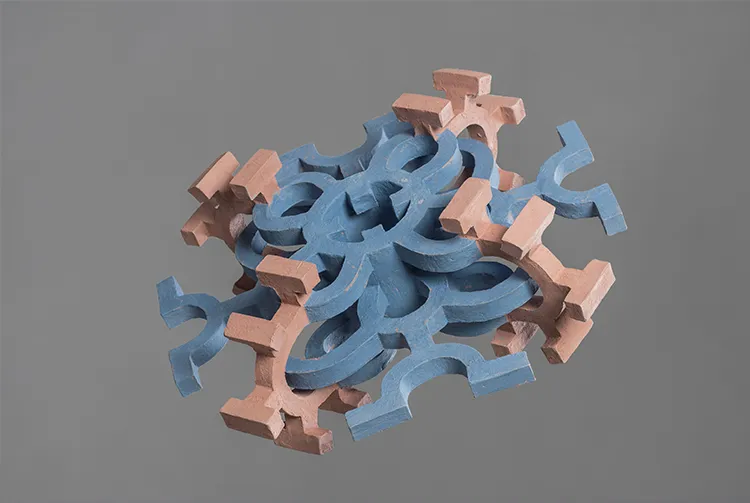
Exploring Dualities and Spirituality
Abeling’s artistic style is characterized by her exploration of contrasts—abstract versus figurative, open versus closed, organic versus geometric, simple versus detailed. These dualities reflect her deep philosophical inquiries into the meaning of human existence and our relationship with the world beyond time and space. Her work often centers on the human figure, not merely as a physical form, but as a vessel for exploring deeper spiritual and existential questions. She is constantly attuned to the multifaceted nature of reality, seeking connections between different realms and questioning how humanity relates to the unseen and the immeasurable.
Abeling’s work delves into the boundaries of the visible world and the mysteries that lie beyond. She poses questions about the extent to which we can perceive the universe or the layers of history beneath our feet. Her art is a response to these inquiries, offering a space for reflection and connection with what lies beyond our immediate senses. For Abeling, creating art is an invitation to slow down, to reflect, and to activate the imagination. This process of creation fosters a sense of wholeness, which she believes is crucial in a world fraught with change and uncertainty. Abeling’s sculptures are not just objects; they are visual poems that speak to the heart, urging a deeper understanding of ourselves, each other, and the natural world.
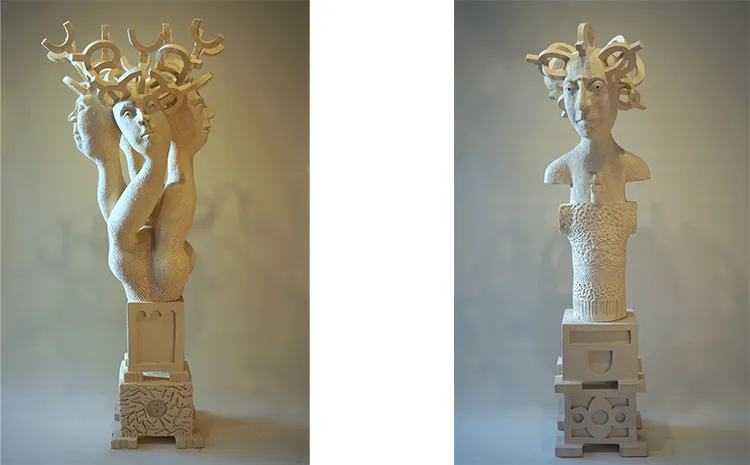
Hedy Abeling: Sacredness in Sculpture
A lifelong dream of Abeling’s materialized with an invitation to exhibit her work alongside her husband, painter Johan Abeling, at Museum Klooster in Ter Apel. This opportunity rekindled her long-held ambition to create modern statues of saints, inspired by the sacred art she had admired during her visit to the Saint-Lazare Cathedral in Autun. Initially, she drew inspiration from the historical significance of the Ter Apel monastery, but her project quickly evolved into a personal exploration of what is truly sacred. For Abeling, sacredness represents a sense of wholeness and connection that transcends the dualities of life—between above and below, inside and outside.
The resulting series of sculptures, including works like ‘Lumini’ and ‘Provocar,’ embody this exploration of opposites. By blending figuration with abstraction, and juxtaposing open and closed forms, organic shapes with geometric structures, Abeling creates pieces that evoke a profound sense of stillness and simplicity. She uses sober white clay, working it with texture and relief to enhance the sculptures’ contemplative quality. These works invite the viewer to reflect on the sacredness that exists in the balance between contrasting forces, and the deep connections that bind us to the universe.
Abeling’s upcoming exhibition, titled “Light and Stillness,” which will open on September 29, 2024, at Museum Klooster, is a culmination of her artistic journey and her quest to understand the sacred. Through her sculptures, she offers a visual meditation on the connections between the earthly and the divine, the visible and the invisible, encouraging viewers to engage with the deeper layers of meaning in their own lives.
